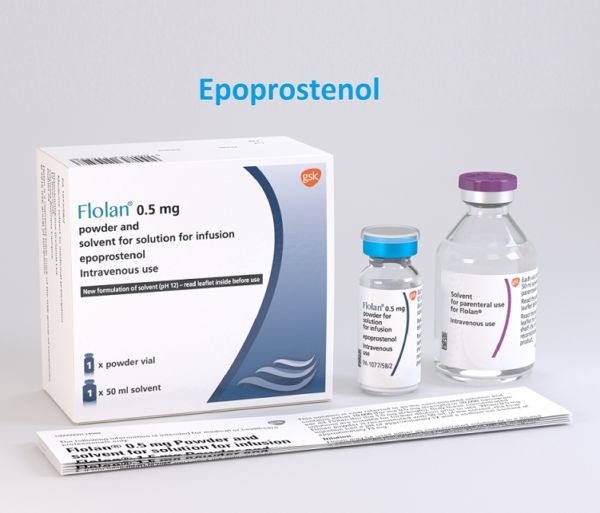
Contents
epoprostenol – injection, Flolan
Medication Uses How To Use Side Effects Precautions Drug Interactions Overdose Notes Missed Dose Storage USES: This medication is used to treat high blood pressure in the lungs (pulmonary arterial hypertension). It helps to increase your ability to exercise and improve symptoms such as shortness of breath and tiredness. It works by relaxing and widening the blood vessels (arteries) in the lungs and other parts of the body so that blood can flow more easily. This medication belongs to a class of drugs known as vasodilators. HOW TO USE: When you first start using this medication, it must be given by a health care professional in a hospital or clinic. This medication is given as a continuous injection into the vein using an infusion pump, or as directed by your doctor.Follow all instructions from your health care professional about how to properly use and prepare this medication and the infusion pump. Learn how to properly care for your injection site and how to avoid infection. Also learn how to store and discard needles and medical supplies safely. Before using, check this product visually for particles or discoloration. If either is present, do not use the liquid, and contact your health care professional immediately. If you have any questions about the use of this medication or the infusion pump, consult your health care professional.Do not suddenly decrease the dose or suddenly stop using this medication because doing either may lead to serious (rarely fatal) worsening of your condition. If you must stop this medication, gradually reduce the dose as directed by your doctor. Consult your doctor immediately if your infusion is interrupted or if you develop worsening trouble breathing, dizziness, or weakness. To avoid interruptions in drug treatment, you should have a backup infusion pump and infusion sets available in case your equipment fails. Consult your health care professional for more information.The dosage is based on your medical condition, weight, and response to treatment. Your doctor may also direct you to use additional medications to treat your condition and prevent problems. Use all prescribed medications exactly as directed.Tell your doctor if your condition does not improve or if it worsens. SIDE EFFECTS: Nausea, vomiting, diarrhea, dizziness, headache, flushing, sweating, abdominal pain, jaw pain, muscle/joint pain, or pain/redness/swelling at the injection site may occur. If any of these effects persist or worsen, tell your doctor or pharmacist promptly.Remember that your doctor has prescribed this medication because he or she has judged that the benefit to you is greater than the risk of side effects. Many people using this medication do not have serious side effects.Tell your doctor immediately if any of these unlikely but serious side effects occur: mental/mood changes (such as anxiety, nervousness, confusion, agitation), signs of infection (such as fever, chills), numb/tingling/pale skin, fast/slow/irregular heartbeat, vision changes, chest pain, unusual bruising/bleeding.A very serious allergic reaction to this drug is rare. However, seek immediate medical attention if you notice any symptoms of a serious allergic reaction, including: rash, itching/swelling (especially of the face/tongue/throat), severe dizziness, trouble breathing.This is not a complete list of possible side effects. If you notice other effects not listed above, contact your doctor or pharmacist.In the US -Call your doctor for medical advice about side effects. You may report side effects to FDA at 1-800-FDA-1088.In Canada – Call your doctor for medical advice about side effects. You may report side effects to Health Canada at 1-866-234-2345.
PRECAUTIONS: Before using epoprostenol, tell your doctor or pharmacist if you are allergic to it; or if you have any other allergies. This product may contain inactive ingredients, which can cause allergic reactions or other problems. Talk to your pharmacist for more details.Before using this medication, tell your doctor or pharmacist your medical history, especially of: heart failure (on the left side of the heart), bleeding problems (such as bleeding of the stomach/intestines), blood disorders (such as thrombocytopenia), liver disease.This drug may make you dizzy. Do not drive, use machinery, or do any activity that requires alertness until you are sure you can perform such activities safely. Limit alcoholic beverages.To lower your risk of dizziness and lightheadedness, get up slowly when rising from a sitting or lying position.During pregnancy, this medication should be used only when clearly needed. Discuss the risks and benefits with your doctor.It is unknown if this drug passes into breast milk. Discuss the risks and benefits with your doctor before breast-feeding. DRUG INTERACTIONS: Your doctor or pharmacist may already be aware of any possible drug interactions and may be monitoring you for them. Do not start, stop, or change the dosage of any medicine before checking with your doctor or pharmacist first.Before using this medication, tell your doctor or pharmacist of all prescription and nonprescription/herbal products you may use, especially of: antiplatelet drugs (such as clopidogrel).Check all prescription and nonprescription medicine labels carefully since many contain pain relievers/fever reducers (aspirin, NSAIDs such as ibuprofen, naproxen) that can increase the risk of bleeding or medicines (such as cough-and-cold products, diet aids) that could increase your blood pressure or heart rate. Ask your pharmacist about using those products safely.However, if your doctor has directed you to take low-dose aspirin for heart attack or stroke prevention (usually at dosages of 81-325 milligrams a day), you should continue taking it unless your doctor instructs you otherwise. Ask your doctor or pharmacist for more details.This document does not contain all possible interactions. Therefore, before using this product, tell your doctor or pharmacist of all the products you use. Keep a list of all your medications with you, and share the list with your doctor and pharmacist. OVERDOSE: If overdose is suspected, contact a poison control center or emergency room immediately. US residents can call their local poison control center at 1-800-222-1222. Canada residents can call a provincial poison control center. Symptoms of overdose may include: severe dizziness. NOTES: Do not share this medication with others.Laboratory and/or medical tests (such as blood pressure, heart rate) should be performed from time to time to monitor your progress or check for side effects. Consult your doctor for more details.
QUESTION
MISSED DOSE: This drug is to be given continuously as an infusion. If your infusion is interrupted, contact your doctor or pharmacist immediately. STORAGE: Store unopened vials at room temperature between 68-77 degrees F (20-25 degrees C) away from light and moisture. Consult your pharmacist for details about the storage of opened vials and prepared solutions. Do not freeze. Do not store in the bathroom. Keep all medicines away from children and pets.Do not flush medications down the toilet or pour them into a drain unless instructed to do so. Properly discard this product when it is expired or no longer needed. Consult your pharmacist or local waste disposal company for more details about how to safely discard your product.MEDICAL ALERT: Your condition can cause complications in a medical emergency. For information about enrolling in MedicAlert, call 1-888-633-4298 (US) or 1-800-668-1507 (Canada). Information last revised March 2013. Copyright(c) 2013 First Databank, Inc.
Related Disease Conditions
High Blood Pressure (Hypertension)
High blood pressure (hypertension) is a disease in which pressure within the arteries of the body is elevated. About 75 million people in the US have hypertension (1 in 3 adults), and only half of them are able to manage it. Many people do not know that they have high blood pressure because it often has no warning signs or symptoms. Systolic and diastolic are the two readings in which blood pressure is measured. The American College of Cardiology released new guidelines for high blood pressure in 2017. The guidelines now state that blood normal blood pressure is 120/80 mmHg. If either one of those numbers is higher, you have high blood pressure. The American Academy of Cardiology defines high blood pressure slightly differently. The AAC considers 130/80 mm Hg. or greater (either number) stage 1 hypertension. Stage 2 hypertension is considered 140/90 mm Hg. or greater. If you have high blood pressure you are at risk of developing life threatening diseases like stroke and heart attack.REFERENCE: CDC. High Blood Pressure. Updated: Nov 13, 2017.
Pulmonary Hypertension
Pulmonary hypertension is elevated pressure in the pulmonary arteries that carry blood from the lungs to the heart. The most common symptoms are fatigue and difficulty breathing. If the condition goes undiagnosed, more severe symptoms may occur. As pulmonary hypertension worsens, some people with the condition have difficulty performing any activities that require physical exertion. While there is no cure for pulmonary hypertension, it can be managed and treated with medications and supplemental oxygen to increase blood oxygen levels.
Pulmonary hypertension is elevated pressure in the pulmonary arteries that carry blood from the lungs to the heart. The most common symptoms are fatigue and difficulty breathing. If the condition goes undiagnosed, more severe symptoms may occur. As pulmonary hypertension worsens, some people with the condition have difficulty performing any activities that require physical exertion. While there is no cure for pulmonary hypertension, it can be managed and treated with medications and supplemental oxygen to increase blood oxygen levels.


